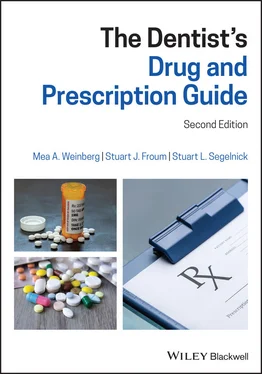13 Q. What is the first step involved in drug absorption?
14 A. The first step before a drug can be absorbed in the small intestine is disintegration of the dosage formulation into a formulation that can easily be absorbed. The stomach might be expected to be the first site of absorption but in reality, very little absorption occurs in the stomach because the surface area is very small. A tablet must break up to expose the active ingredient, which takes some time. A capsule must open up, which takes less time than a tablet. A solution is already in a liquid, easily absorbed form and takes the least time for disintegration and absorption. The order of bioavailability is oral solution > oral suspension > capsule > tablet (Lloyd et al. 1978).
15 Q. Is there any systemic absorption of a topical anesthetic applied on the surface of the gingiva?
16 A. Yes. The purpose of topical agents is to maximize the concentration of the drug at the target site while minimizing potential systemic adverse effects. Although drug absorption is not desired, there could be some systemic absorption, especially if the agent is applied on abraded gingiva or skin. Because of its lipophilic nature, the stratum corneum of the skin may act as a reservoir for many drugs. Consequently, the local effects of the drug may persist long enough to allow once‐daily application. For example, once‐daily application of corticosteroid preparations is as effective as multiple applications in most circumstances. Direct access to the skin may predispose the patient to frequent topical applications, increasing the risk of systemic adverse effects.
17 Q. How does a drug get absorbed into the systemic circulation?
18 A. A drug must pass through many cell membranes to get into the blood. A drug must have some water solubility to go through aqueous fluids and some lipid solubility to get through the cell membrane, which is composed of two layers of phospholipids.
19 Q. What is the purpose of epinephrine added to local anesthetics?
20 A. Epinephrine is a vasoconstrictor that acts to constrict blood vessels to decrease blood flow in the submucosal area via activating alpha‐1 receptors (Becker and Reed 2012). This allows the anesthetic solution to stay at the site of action longer, which slows absorption of the anesthetic solution.
21 Q. What is drug distribution and what factors affect distribution?
22 A. Drug distribution is the movement of an agent through the blood or lymph to various sites of action in the body. An important factor affecting drug distribution is protein binding. Many drugs in the blood are bound to circulating proteins such as albumin for acidic drugs (e.g., penicillin, barbiturates, aspirin, vitamin C) and acid glycoproteins and lipoproteins for basic drugs (e.g., narcotic analgesics, erythromycin). When drugs are bound to plasma proteins, they are inactive while circulating in the blood. This binding to proteins is temporary, reversible, and can convert to free drug. Only drugs that are not bound to plasma proteins are “freely active” and bind to specific receptors on the target tissue/organ. Another factor that affects drug distribution is blood flow to the target organs.
23 Q. What is the minimum effective concentration (MEC) of a drug?
24 A. The minimum effective concentration (MEC) is the amount of drug required to produce a therapeutic effect. This is important to know because a drug should not be given above the MEC as this will produce toxic concentrations. The ideal concentration of a drug should be between the MEC and the toxic concentration. This is referred to as the therapeutic range. For example, after periodontal surgery, it is recommended that the patient take ibuprofen (Motrin®, Nuprin®). If the patient decides to take only one 200 mg tablet during the day, they will still experience pain because the therapeutic range was not reached. The patient should take two or three tablets which will increase the plasma level of ibuprofen into the therapeutic range. If the patient takes five or more tablets at one time, then adverse effects may occur because the plasma level of ibuprofen is outside the therapeutic range and the maximum dose has been exceeded. Beyond the maximum dose, the analgesic effect does not increase.
25 Q. What does the term “dose” mean?
26 A. The dose of a drug is the amount of drug taken at any one time. Dose is expressed as the weight of drug (e.g., 500 mg), the number of dosage forms (e.g., one capsule), or the volume of liquid (e.g. two drops).
27 Q. What is the elimination half‐life of a drug?
28 A. The elimination half‐life (t½) of a drug is essentially the duration of action of a drug. Also, it is used to determine the dosing of a drug. The elimination half‐life of a drug is the amount of time required for a drug to decrease its original concentration by 50%. The second half‐life is when it removes another 50%, leaving 25% in the blood. The third half‐life is when it removes another 50%, leaving 12.5% in the blood. Drugs have different predetermined half‐lives. As repeated doses of a drug are administered, the plasma concentration builds up and reaches “steady state.” Steady state occurs when the amount of drug in the plasma builds up to a level considered therapeutically effective. In order to achieve steady state, the amount of drug administered must balance the amount being cleared from the body. It usually takes about between four and five half‐lives to reach clinical steady state and about six half‐lives before 98% of the drug is eliminated from the body (Ito 2011). For example, if a drug has a t½ of 2 hours, it will take about 8–10 hours to reach clinical steady state (Ito 2011).Drugs with a short t½ are eliminated faster than drugs with a long t½. For example, tetracycline HCl has a t½ of 6–12 hours and doxycycline hyclate has a t½ of 14–24 hours. Thus, tetracycline dosing is one capsule every four hours while doxycycline is dosed 100 mg every 12 hours on day 1, then 100 mg every day. On average, doxycycline's half‐life is around 19 hours. By multiplying 19 hours by six hours (average t½ to be 98% eliminated from the body) (19 × 6 = 114 hours), it takes 114 hours, or about five days, before 98% of the doxycycline has been removed from the body. Penicillin VK has a t½ of 30 minutes and amoxicillin's t½ is 1–1.3 hours. Thus, penicillin is given every six hours and amoxicillin is dosed every eight hours (Thomson 2004a,b).Ibuprofen has a short t½ and is cleared from the body more rapidly than a drug with a longer t½. Ibuprofen requires a more frequent, regular dosing regimen of 200–400 mg (OTC strength) q4–6h or prescription ibuprofen 600–800 q6–8h in order to build up and maintain a high enough concentration in the plasma to be therapeutically effective.
29 Q. What is the volume of distribution (VD)?
30 A. Apparent volume of distribution (VD) refers to the amount of drug in the various tissues of the body. Volume of distribution is a calculated value referring to the volume of fluid (e.g., plasma, interstitial fluid [fluid between the cells], and lymph) in which a drug is able to distribute to the organs. The volume of distribution can be used to calculate the LD, MD, and clearance of a drug (Aki et al. 2010; Thomson 2004a, b; Wesolowski et al. 2016).
31 Q. What is drug biotransformation?
32 A. Drug biotransformation (or metabolism, as it is sometimes called) terminates the action of a drug. It is a process by which a substance changes from one chemical form to another via a reaction in the body. Usually, biotransformation occurs in the liver but can also occur in the plasma and kidney.
33 Q. What is the importance of drug clearance?
34 A. Clearance refers to the volume of fluid (e.g., plasma) that would be completely cleared of drug if the entire drug being excreted were removed from that volume of fluid. Essentially, clearance is the removal of a drug from the plasma. It is a calculated value and measured in liters/hour. Clearance indicates the ability of the liver and kidney to eliminate a drug from the body (Doogue and Polasek 2013). Clearance may be reduced in the elderly. Both clearance and VD are important values in determining the half‐life of a drug (Gossel 1998a,b).
Читать дальше












